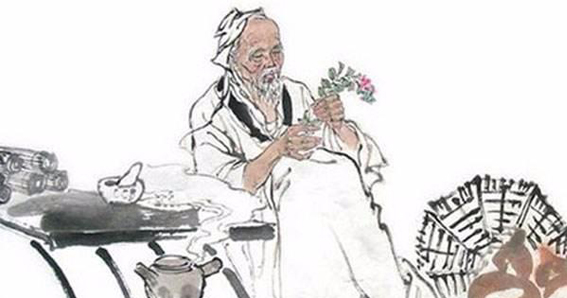Wǔ Qín Xì 五禽戏 (Five Animals' Game) is a series of Qì Gōng 氣功 exercises, designed to strengthen the body and preserve health, which mimic the movement of five animals: tiger, deer, bear, monkey and bird.
Origins of Wu Qin Xi:
The creation of this series of therapeutic exercises is usually attributed to one of the most important physicians of Traditional Chinese Medicine, Huá Tuó 華佗 (145-208), who lived during the Hàn 漢 dynasty. Huá Tuó was the first physician in history to use anesthesia. One thousand six hundred years before it was first used in Europe, he treated the patient by supplying him or her with a blend of wine with cannabis powder.
According to the first writings found, the purpose of the exercises of the Wǔ Qín Xì was to strengthen the limbs, increase longevity, promote the flow of qì 氣 in the body and, in general, mantaining health.

Painting depicting the physician Huá Tuó 華佗, who is credited with creating these exercises.
In these texts there are no drawings that clarify the exercises, and the written description is rather scarce, so we cannot know how much the original exercises resembled those practiced today, although it is known that they enjoyed great popularity during the Jìn 晉 dynasty (265-420) and the Northern and Southern Dynasties 南北朝 (420-581) to later decline. Until the end of the Míng Míng 大明 dynasty (1368-1644) no explanatory works were drafted with illustrations of each movement. In the twentieth century, after many centuries in the gloom, the popularity of the Wǔ Qín Xì reemerged, and today it is one of the most practiced Qì Gōng exercises in the world.
With regard to the choice of the five animals, consideration has been given to the possibility that the animals were based either on the shamanic origin of some of them or on their relationship to the medicinal substances obtained from them.
Possible shamanic origin:
Bear, tiger, crane and deer are animals that are among those depicted in the ornamental objects and dances of the ancient shamans, with bear and crane being the most common among these four. During the Zhōu 周 dynasty (1122-249 BC), a ritual known as the Great Exorcism (大儺 Dà Nuó) was practiced in the New Year festivities, consisting of the dance of a shaman who, dressed in a bearskin, drove away the evil spirits of the locality.
Also, on the death of the daughter of King Hélǘ 闔閭 of the State of Wú 吳國, he ordered public representations of the Crane Dance, a symbol of triumph over death.
Relationship with medicinal substances:
There is another hypothesis that tries to explain the choice of these five animals as a prototype for the exercises of the Wǔ Qín Xì, based on their relation with the medicinal substances obtained from them for the production of remedies and medicines.
Tiger, bear and some birds, such as duck or hen, are animals that have enjoyed great notoriety within Traditional Medicine because of the belief, common among the Chinese, that their bones and other substances obtained from them possess medicinal properties. Considering these animals as bearers of these same properties, it is possible that the creator of the Wǔ Qín Xì exercises concluded that by mimicking the movements of these animals the same benefits could be obtained as by consuming the substances they produce.
However, these hypotheses also raise some questions; perhaps the most important is that the presence of the monkey among the five animals does not fit with either explanation. On the other hand, there is the question of why the creator of the exercises chose animals whose longevity is not particularly noteworthy. Also, if the exercises are intended to stimulate the flexibility and mobility of the joints, there are better examples of these qualities within the animal kingdom than bear, crane or deer. At the moment, we have no answer to these questions and, in the absence of a better one, the most valid explanation is the one based on the above-mentioned hypotheses.

Illustration of the Five Animals exercises as currently practiced.
Introduction of the Five Phases Theory in the Wu Qin Xi:
Currently, the exercises of the five animals relate to the Five Phases Theory as follows:
- Tiger: metal, lung, sadness, skin diseases.
- Bear: water, kidneys, fear, cold, ears and bones.
- Deer: wood, liver, anger, muscles and eyes.
- Crane: Fire, heart, joy, arteries and tongue.
- Monkey: Earth, spleen and anxiety.
This association has given the exercises of the Wǔ Qín Xì great credibility within the scope of Traditional Chinese Medicine, since the Theory of the Five Phases is one of its main foundations.
However, it is known that during the Hàn dynasty, the time in which the exercises were codified, the existing classification system was very different, and was based on the external morphology of the animals:
- Wood: animals covered with scales.
- Fire: covered with feathers.
- Earth: naked.
- Metal: covered with hair.
- Water: covered with bony armor.
The absence of references to the Five Phases Theory in the documents on physical exercises for health practiced during the Hàn dynasty leads us to the conclusion that, in its origins, the Wǔ Qín Xì did not consider this theory as a basis for his practice.
Despite all this, the exercises of the Game of Five Animals remain a useful way to take care of the body, strengthen the muscles, increase flexibility and maintain joint mobility and, because of all that, it is one of the exercises of Qì Gōng more practiced all over the world.
Sources:
- Qigong y Medicina en la China Antigua, Pedro Jesús Jiménez Martín y Haoqing Liu, Miraguano Ediciones, Madrid, 2015.
- The Way of Qigong: The Art and Science of Chinese Energy Healing, Kenneth S. Cohen, The Random House Publishing Group, Toronto, 1997.
